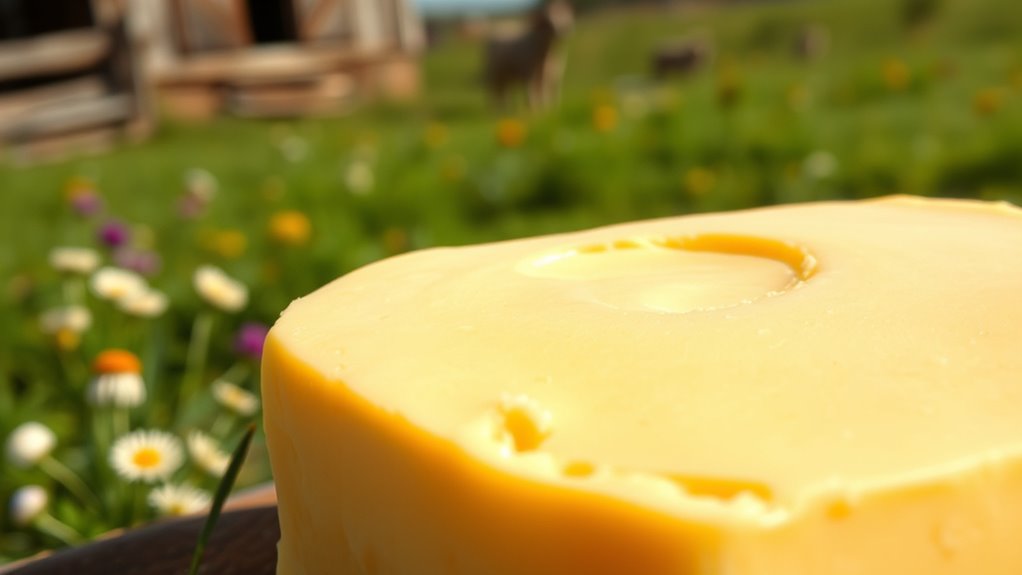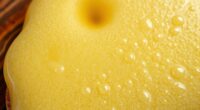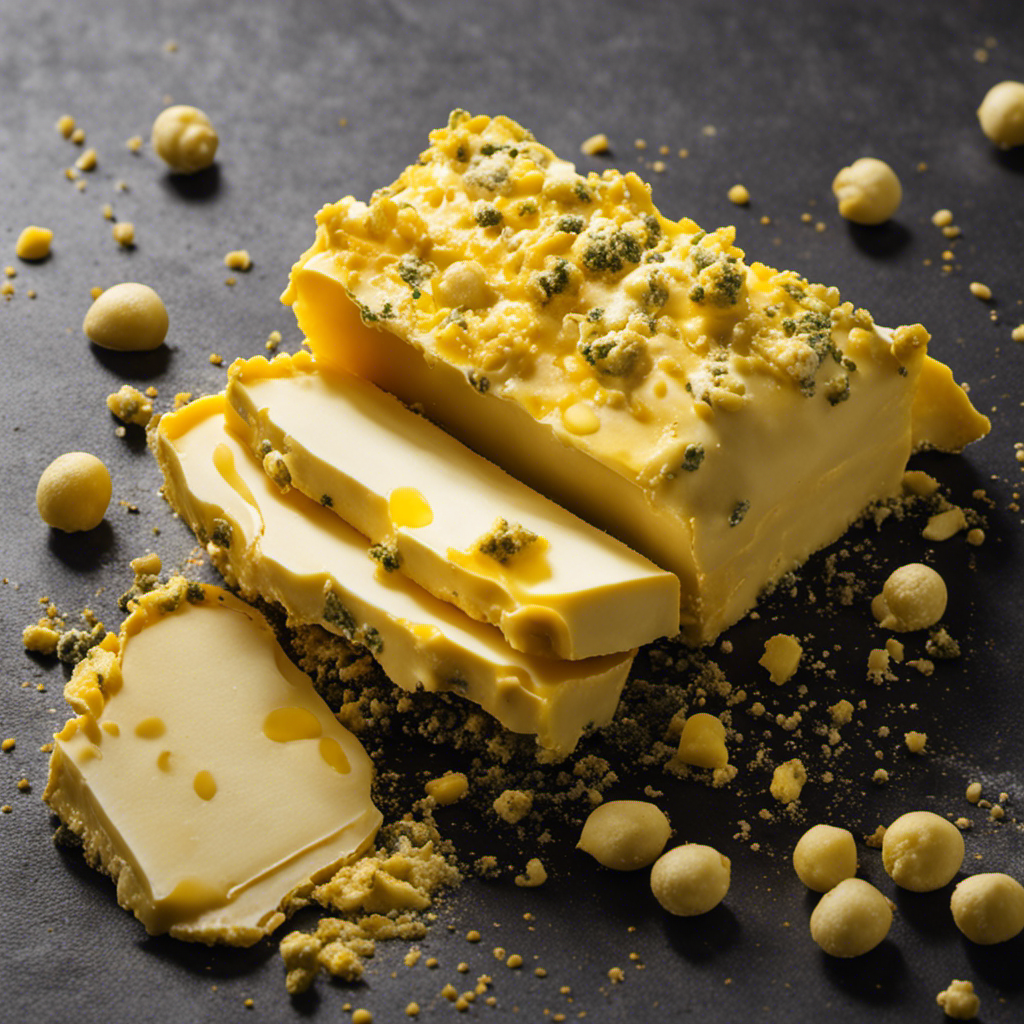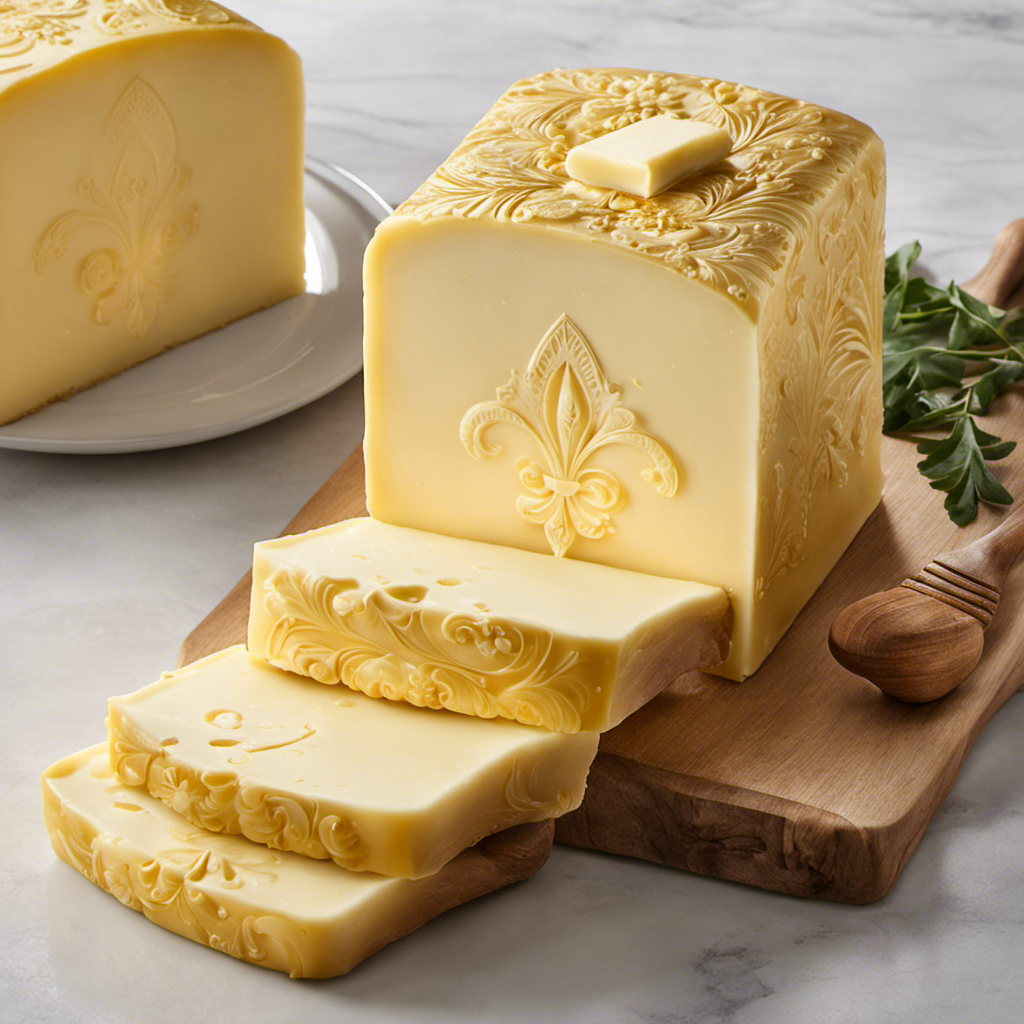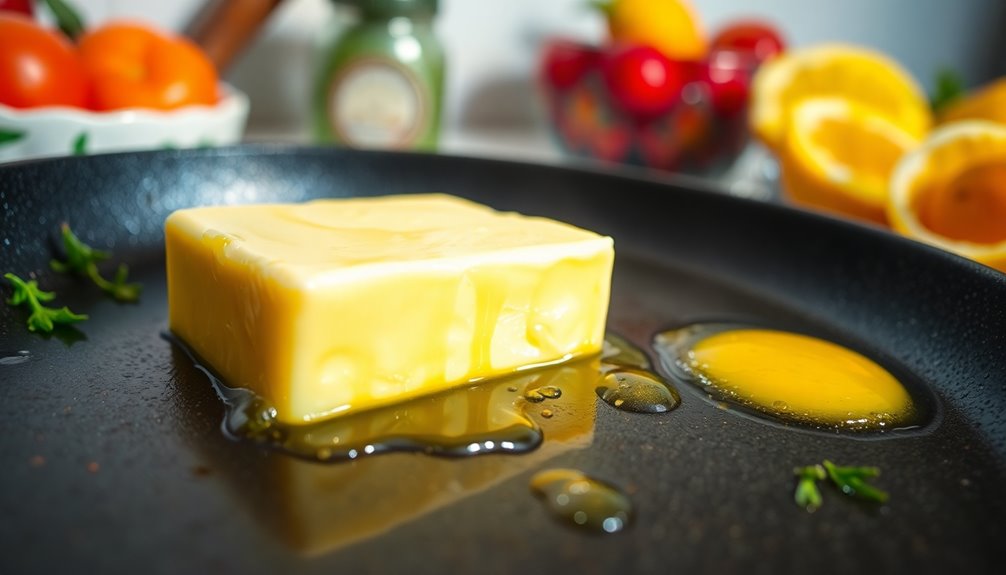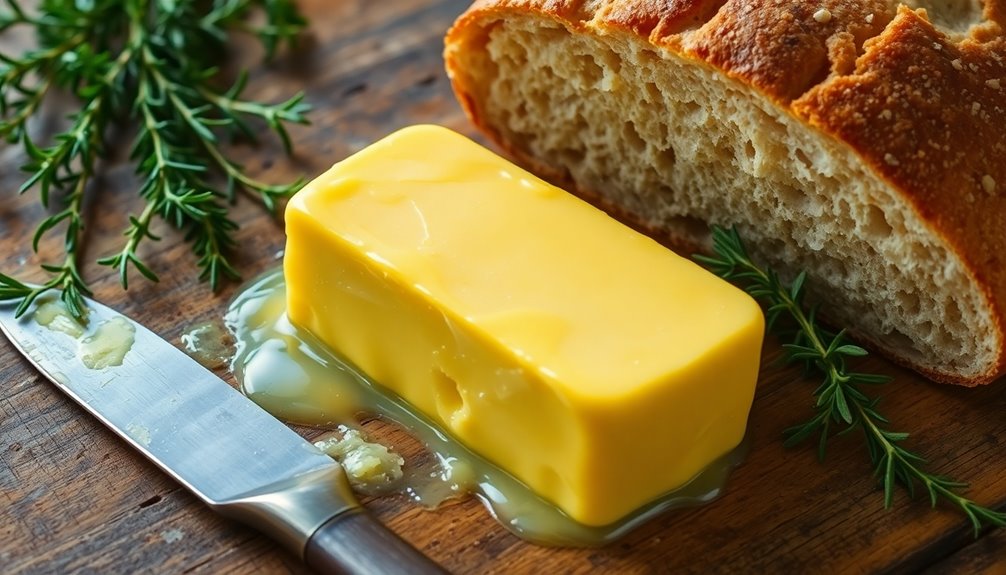Your cow’s diet, especially the intake of carotenoids from fresh greens and forage, directly influences butter’s vibrant hue and flavor. Seasonal changes in pasture and feed affect these pigments, making butter more colorful and flavorful in spring and summer, and paler in winter. Grazing on fresh greens adds grassy and herbal notes. When you explore further, you’ll discover how managing feed and understanding seasonal shifts helps achieve consistent butter quality year-round.
Key Takeaways
- Carotenoid-rich forage from cow diets enhances butter’s golden color and vibrancy.
- Seasonal feed changes cause fluctuations in milk carotenoid levels, affecting butter hue.
- Grazing on fresh greens imparts grassy and herbal flavors to butter, varying with season.
- Winter diets with less fresh forage lead to paler butter and altered taste profiles.
- Proper feed balancing maintains consistent butter color and flavor throughout the year.
The Role of Carotenoids in Butter Color

Carotenoids are natural pigments that considerably influence the color of butter, giving it a rich, golden hue. When cows consume carotenoid-rich forage, your body absorbs these compounds through carotenoid absorption processes, which directly affects butter’s shade. The more carotenoids you ingest, the more vibrant the butter’s color becomes. However, pigment stability also plays a vital role; factors like light, heat, and storage conditions can degrade these pigments, causing color fading over time. To maintain the desired golden tone, it’s essential to manage both carotenoid intake and storage environments carefully. Understanding how carotenoid absorption works and ensuring pigment stability helps producers produce butter with consistent, appealing color, reflecting the health of the cows’ diet and the quality of the final product. Additionally, incorporating interior decor ideas inspired by traditional country styles can create a cozy environment that highlights the natural beauty of the butter’s color in your presentation or kitchen display.
Seasonal Variations in Cow Diet and Their Impact
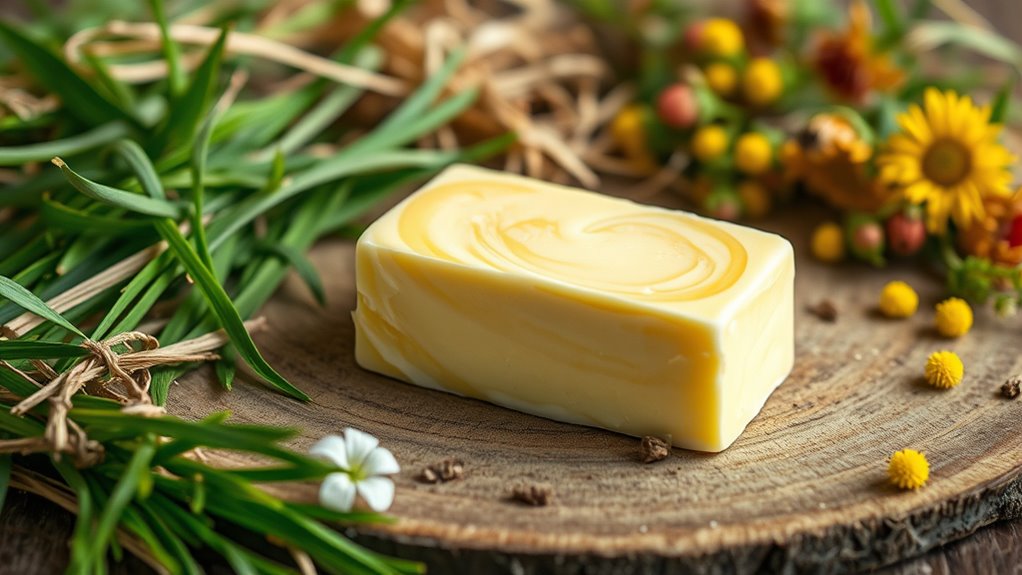
Seasonal changes in pasture availability and crop growth considerably influence the diet of dairy cows throughout the year. During different seasons, their feed shifts, affecting butter color and flavor. You should consider:
Seasonal pasture and crop changes significantly impact dairy cow diets and butter color throughout the year.
- Dairy cow genetics determine how efficiently cows convert seasonal forage into milk, influencing pigment deposition.
- Seasonal feed variations alter carotenoid intake, directly impacting butter’s hue.
- Milk processing techniques can enhance or diminish seasonal color differences, especially when blending milk from various sources.
- Consistent monitoring of pasture quality helps producers adjust feed and maintain butter color consistency year-round.
- The type of feed, such as specific electric bikes used on farms, can influence the efficiency of pasture management and feed delivery, indirectly affecting milk quality and butter color.
Understanding these factors enables you to appreciate how seasonal diet changes shape butter’s hue, ensuring quality and appeal regardless of the time of year.
How Grazing on Fresh Greens Influences Butter Flavor
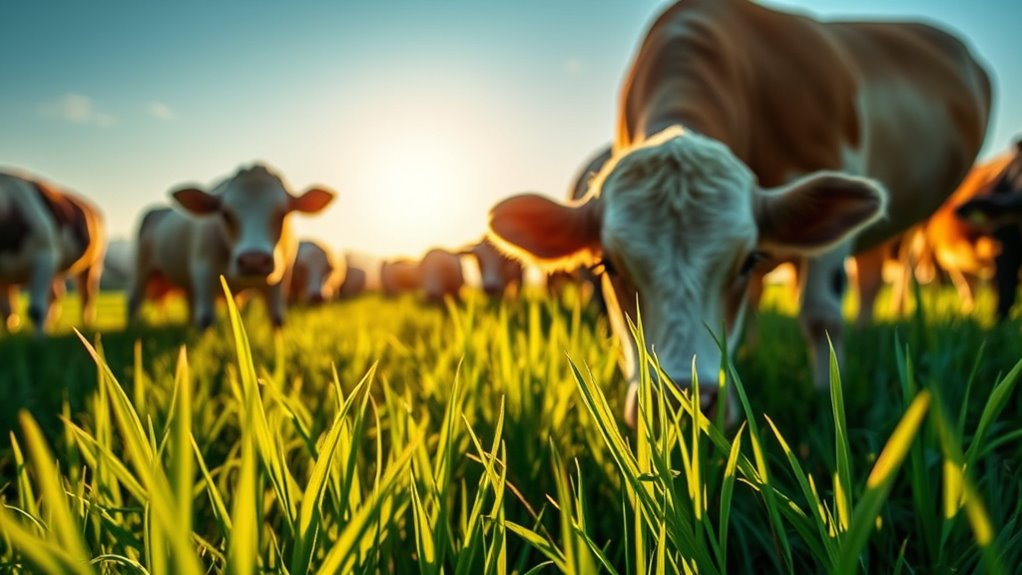
Grazing on fresh greens directly impacts the flavor profile of butter produced from pasture-fed cows. The grass influence introduces bright, grassy notes that enhance flavor development, making the butter taste fresher and more vibrant. When cows consume young, tender greens, their milk inherits subtle herbal and floral nuances, enriching the final product. The variety of grasses and greens available in the pasture also plays a role, creating a complex, layered flavor. This direct connection between diet and butter flavor highlights how seasonal changes and grazing choices shape the taste experience. By grazing on fresh greens, you’re fundamentally influencing the butter’s aroma, depth, and overall character, resulting in a more nuanced and appealing flavor that reflects the cow’s natural grazing environment. Seasonal changes in pasture also influence the availability and variety of greens, further impacting flavor complexity.
The Transition From Spring to Winter: Changes in Milk Composition
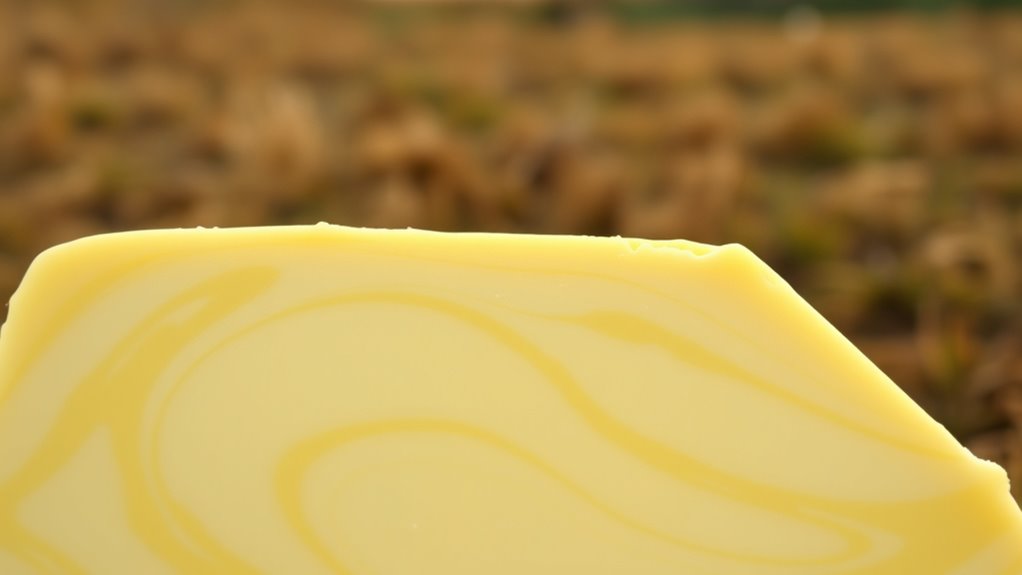
As the year shifts from the vibrant greens of spring to the cooler, dormant months of winter, milk composition undergoes significant changes. You’ll notice lower levels of beta-carotene, which impacts color and flavor. During this period, dairy processing teams adjust techniques like milk homogenization to maintain quality.
Consider these key points:
- Milk’s fat content increases, affecting butter yield.
- The vitamin A levels decline, influencing nutritional value.
- Protein composition shifts, impacting texture and taste.
- Seasonal feed changes lead to a different flavor profile.
These variations directly influence butter color and taste. Understanding these seasonal shifts helps producers refine dairy processing methods, ensuring consistent quality despite natural changes in milk composition.
The Art of Balancing Feed to Achieve Consistent Butter Quality

Maintaining consistent butter quality requires carefully balancing cow feed, especially as natural variations in milk composition occur throughout the year. Feed optimization is essential to guarantee your cows receive the right nutrients to produce uniform milk, which directly affects butter’s hue and flavor. By adjusting feed components—such as hay, silage, or supplement mixes—you can manage seasonal fluctuations that impact milk fat and protein levels. This precise balancing act helps stabilize butter’s flavor and color, preventing undesirable shifts. Regular monitoring of milk composition guides feed adjustments, ensuring flavor consistency and the desired butter quality. Incorporating insights from natural techniques for seed production can also offer innovative approaches to optimize feed quality and nutrient content, further supporting consistent butter characteristics. Mastering this art allows you to produce butter with predictable color and taste, regardless of seasonal changes, fostering consumer trust and product excellence.
Frequently Asked Questions
Can Artificial Coloring Be Used to Modify Butter’S Hue Legally?
You might wonder if artificial coloring like food dye can legally alter butter’s hue. The answer depends on local legal regulations, which vary by region. Generally, food dye is permitted if approved by food safety authorities, but some places restrict or require labeling for artificially colored products. Always check your area’s regulations to ensure that using food dye to modify butter’s color complies with legal standards.
How Do Regional Climates Affect Cow Diet and Butter Color?
Regional climates influence cow diets through pasture diversity and seasonal variations, which in turn affect butter color. In warmer regions with lush pastures year-round, cows consume more carotenoid-rich plants, resulting in richer, golden butter. Conversely, cooler climates with limited growing seasons lead to less vibrant hues. You’ll notice these differences in butter color and flavor, reflecting the local environment’s impact on cow feed and the seasonal availability of diverse forage.
Are There Specific Cow Breeds That Produce More Vibrant Butter Colors?
You might wonder if certain cow breeds produce more vibrant butter colors. Breed differences and genetic factors do influence this, as some breeds naturally deposit more carotenoids into their milk, resulting in richer hues. For example, Jerseys and Guernseys tend to produce butter with a deeper yellow or golden tone. So, choosing specific breeds can enhance butter color, but diet still plays a key role in achieving the desired hue.
What Role Do Supplements Play in Altering Butter Flavor and Appearance?
Imagine your dairy cow’s diet as a painter’s palette, where supplements add vivid strokes to the canvas. These supplements, along with seasonal feeding practices, influence both butter flavor and appearance. By adjusting dairy cow nutrition, you can enhance creaminess or deepen color, making your butter uniquely appealing. Supplements act as the artist’s brush, subtly shaping the final hue and taste, giving your butter a signature touch that reflects careful management.
How Does Storage Time Influence the Color and Taste of Butter?
You’ll notice that butter aging and storage conditions greatly influence its color and taste over time. As you store butter, it can darken slightly due to oxidation, and its flavor may develop deeper, more complex notes. Proper storage in a cool, airtight environment slows down these changes, preserving freshness. Without ideal conditions, butter can spoil faster, losing its vibrant hue and fresh taste, so pay attention to how long and where you keep it.
Conclusion
Don’t let seasonal changes discourage you from enjoying rich, vibrant butter. By understanding how cow feed and seasons influence color and flavor, you can appreciate the natural craftsmanship behind each batch. Yes, it’s a dynamic process, but that’s what makes every spread unique and special. Embrace the journey from pasture to plate—your taste buds will thank you for the authentic, wholesome experience. After all, isn’t that what true quality is all about?
